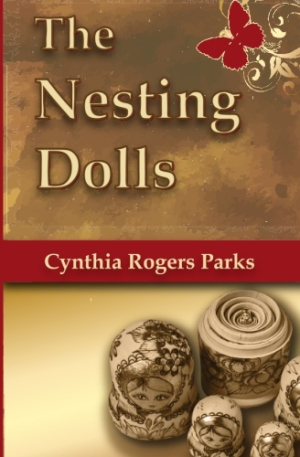The Nesting Dolls
Parks confronts racism and immigration issues in the World War II era without mincing words.
For the successive generations of Russian women in Cynthia Rogers Parks’s poignant novel, The Nesting Dolls, repercussions of their actions reverberate in powerful ways. This book touches on themes of mother-daughter relationships, love, loss, immigration, and emigration.
The bulk of the book centers around the Petrovs, a Russian family struggling to survive the upheaval they experience following World War II. The matriarch, Olena, worries for the futures of her daughters, Katya and Maria, and, to a lesser degree, her husband, Sergei.
Skillfully using third-person limited narration to invest the audience in her characters, Parks has Maria sagely observe, “Shanghai, like Mama, never really slept.” And there is much to cause insomnia in the bustling Chinese city the family inhabits; the spot-on descriptions plunge readers into the chaos along with Olena: “It was as if someone had only just tumbled a busy hive and its inhabitants, half human, half mechanical, were emerging shocked and stupefied, angry and lethargic, purposeful and aimless, unified in nothing but the strange buzzing din of voices.” Whether describing the inside of an American military mess hall or summing up a character’s personality, Parks adroitly uses language to her advantage.
The author repeatedly addresses the harsher side of motherhood as Olena loses her daughters to marriage, and Maria’s daughter Ana becomes a pawn in a troubled union. When the setting shifts from postwar Shanghai to postwar America, where Maria struggles to adjust to life on her mother-in-law’s Georgia estate, issues of emigration and loss continue to pop up. Branded a foreigner, Maria finds that her habit of acquiring new words in other languages is disdained by her husband’s family. The story also confronts the era’s racism without mincing words. Parks offers the mother-in-law’s indignant rants: “Didn’t she [Maria] know that Negroes raped and murdered white women? Was she not aware of their filth and diseases?” Lonely Maria becomes confused, and the audience is firmly on her side during this verbal assault.
Like her mother, Ana feels disconnected from her family due to circumstances beyond her control. Ana’s own daughter, Emily, also experiences emptiness until voices from the past reveal the truth, bringing things full circle for all the women.
In comparison to the stories of Olena, Katya, and Maria, the tales of adult Ana and Emily feel rushed. The sections about Ana and Emily contain copious summary paragraphs, which is a shame, given the effort Parks makes to develop Olena, Katya, and Maria. Olena’s section comprises the most pages, with Emily’s being the smallest. While this narrative structure nestles the stories within one another to brilliantly mimic the Russian nesting dolls referenced in the book’s title, the literary device would have been more successful if it hadn’t deprived the audience of the opportunity to know Ana and Emily as intimately as Olena, Maria, and Katya. But this pacing hiccup ultimately does little to diminish the novel, which is sure to resonate with mothers and those who love intergenerational sagas.
Reviewed by
Jill Allen
Disclosure: This article is not an endorsement, but a review. The publisher of this book provided free copies of the book and paid a small fee to have their book reviewed by a professional reviewer. Foreword Reviews and Clarion Reviews make no guarantee that the publisher will receive a positive review. Foreword Magazine, Inc. is disclosing this in accordance with the Federal Trade Commission’s 16 CFR, Part 255.

